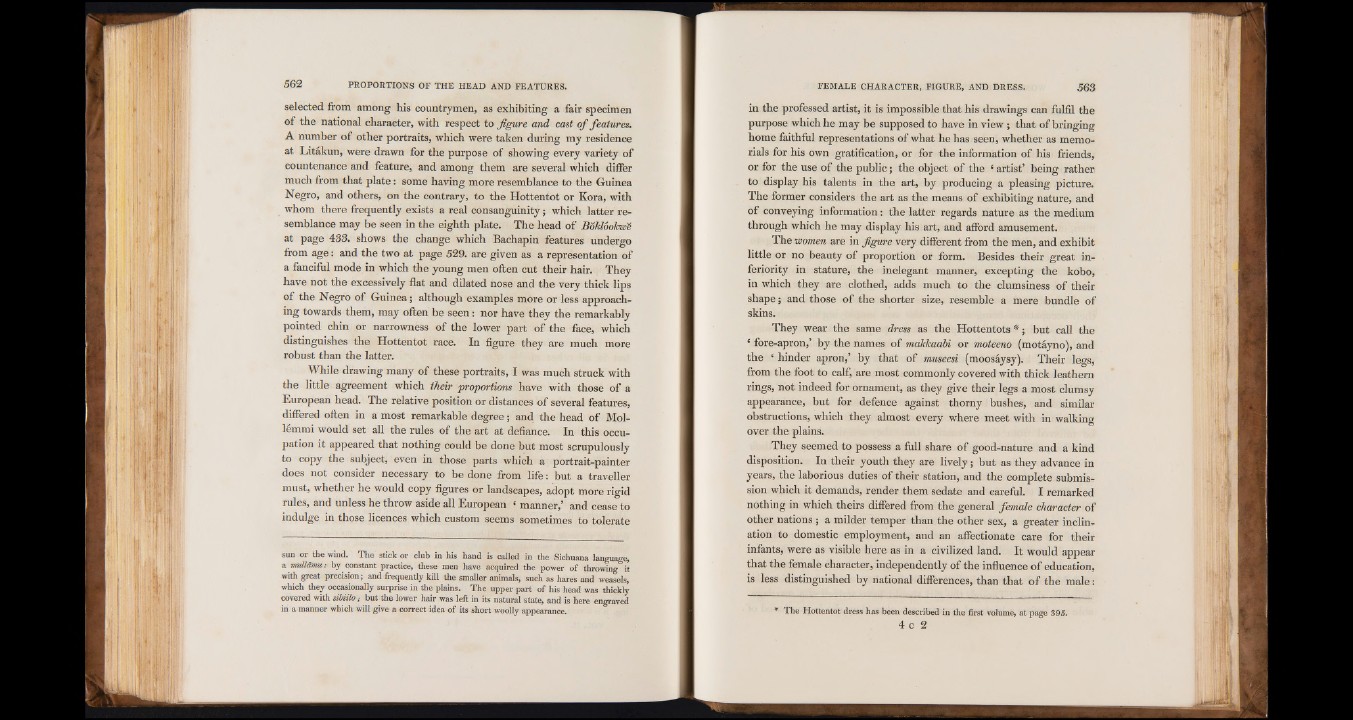
562 PROPORTIONS OF THE HEAD AND FEATURES.
selected from among his countrymen, as exhibiting a fair specimen
of the national character, with respect to figure and cast of features.
A number of other portraits, which were taken during my residence
at Litakun, were drawn for the purpose of showing every variety of
countenance and feature, and among them are several which differ
much from that plate: some having more resemblance to the Guinea
Negro, and others, on the contrary, to the Hottentot or Kora, with
whom there frequently exists a real consanguinity; which latter resemblance
may be seen in the eighth plate. The head of BoklookwZ
at page 433. shows the change which Bachapin features undergo
from age: and the two at page 529. are given as a representation of
a fanciful mode in which the young men often cut their hair. They
have not the excessively flat and dilated nose and the very thick lips
of the Negro of Guinea; although examples more or less approaching
towards them, may often be seen: nor have they the remarkably
pointed chin or narrowness of the lower part of the face, which
distinguishes the Hottentot race. In figure they are much more
robust than the latter.
While drawing many of these portraits, I was much struck with
the little agreement which their proportions have with those of a
European head. The relative position or distances of several features,
differed often in a most remarkable degree; and the head of Mol-
lemmi would set all the rules of the art at defiance. In this occupation
it appeared that nothing could be done but most scrupulously
to copy the subject, even in those parts which a portrait-painter
does not consider necessary to be done from life: but a traveller
must, whether he would copy figures or landscapes, adopt more rigid
rules, and unless he throw aside all European ‘ manner,’ and cease to
indulge in those licences which custom seems sometimes to tolerate
sun or the wind. The stick or club in his hand is called in the Sichuana language,
a mulldmu: by constant practice, these men have acquired the power of throwing it
with great precision; and frequently kill the smaller animals, such as hares and weasels,
which they occasionally surprise in the plains. The upper part of his head was thickly
covered with sibiilo ,■ but the lower hair was left in its natural state, and is here engraved
in a manner which will give a correct idea of its short woolly appearance.
FEMALE CHARACTER, FIGURE, AND DRESS. 563
in the professed artist, it is impossible that his drawings can fulfil the
purpose which he may be supposed to have in view ; that of bringing
home faithful representations of what he has seen, whether as memorials
for his own gratification, or for the information of his friends,
or for the use of the public; the object of the ‘ artist’ being rather
to display his talents in the art, by producing a pleasing picture.
The former considers the art as the means of exhibiting nature, and
of conveying information: the latter regards nature as the medium
through which he may display his art, and afford amusement.
The women are in figure very different from the men, and exhibit
little or no beauty of proportion or form. Besides their great inferiority
in stature, the inelegant manner, excepting the kobo,
in which they are clothed, adds much to the clumsiness of their
shape; and those of the shorter size, resemble a mere bundle of
skins.T
hey wear the same dress as the Hottentots *; but call the
‘ fore-apron,’ by the names of mahkaabi or moteeno (motayno), and
the ‘ hinder apron,’ by that of mmeesi (moosaysy). Their legs,
from the foot to calf, are most commonly covered with thick leathern
rings, not indeed for ornament, as they give their legs a most clumsy
appearance, but for defence against thorny bushes, and similar
obstructions, which they almost every where meet with in walking
over the plains.
They seemed to possess a full share of good-nature and a kind
disposition. In their youth they are lively; but as they advance in
years, the laborious duties of their station, and the complete submission
which it demands, render them sedate and careful. I remarked
nothing in which theirs differed from the general female character of
other nations ; a milder temper than the other sex, a greater inclination
to domestic employment, and an affectionate care for their
infants, were as visible here as in a civilized land. It would appear
that the female character, independently of the influence of education,
is less distinguished by national differences, than that of the male:
* The Hottentot dress has been described in the first volume, at page 395.
4 c 2